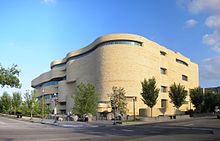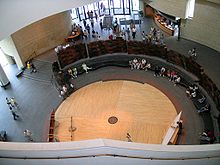- National Museum of the American Indian
-
Coordinates: 38°53′18″N 77°01′00″W / 38.8883°N 77.0166°W
National Museum of the American Indian Established 1989-2004 Location Fourth Street and Independence Avenue, Southwest, Washington D.C. Director Kevin Gover Website National Museum of the American Indian The National Museum of the American Indian is a museum operated under the auspices of the Smithsonian Institution that is dedicated to the life, languages, literature, history, and arts of the native Americans of the Western Hemisphere. It has three facilities: the National Museum of the American Indian on the National Mall in Washington, D.C., which opened on September 21, 2004, on Fourth Street and Independence Avenue, Southwest; the George Gustav Heye Center, a permanent museum in New York City; and the Cultural Resources Center, a research and collections facility in Suitland, Maryland.
Contents
History
George Gustav Heye (1874–1957) traveled throughout North and South America collecting native objects. His collection was assembled over 54 years, beginning in 1903. He started the Museum of the American Indian and his Heye Foundation in 1916. The Heye Foundation's Museum of the American Indian opened to the public on Audubon Terrace in New York City in 1922. The current name was established in 1989 through an Act of Congress following a controversy over Native leaders' discovery that the Smithsonian Institution held more than 18,000 Indian remains, mostly in storage. The Heye collection became part of the Smithsonian in June 1990, and represents approximately 85% of the holdings of the NMAI. The NMAI was initially housed in lower Manhattan at the Alexander Hamilton U.S. Custom House, which remains an exhibition site; its building on the Mall in Washington, DC opened in 2004.
Locations
National Mall
The site on the National Mall opened in September 2004. Fifteen years in the making, it is the first national museum in the country dedicated exclusively to Native Americans. The five-story, 250,000-square-foot (23,000 m2), curvilinear building is clad in a golden-colored Kasota limestone designed to evoke natural rock formations shaped by wind and water over thousands of years. The museum is set in a 4.25 acres (17,200 m2)-site and is surrounded by simulated wetlands. The museum’s east-facing entrance, its prism window and its 120-foot (37 m) high space for contemporary Native performances are direct results of extensive consultations with Native peoples. Similar to the Heye Center in Lower Manhattan, the museum offers a range of exhibitions, film and video screenings, school group programs, public programs and living culture presentations throughout the year.
The museum’s architect and project designer is the Canadian Douglas Cardinal (Blackfoot); its design architects are GBQC Architects of Philadelphia and architect Johnpaul Jones (Cherokee/Choctaw). Disagreements during construction led to Cardinal's being removed from the project, but the building retains his original design intent. His continued input enabled its completion.
The museum’s project architects are Jones & Jones Architects and Landscape Architects Ltd. of Seattle and SmithGroup of Washington, D.C., in association with Lou Weller (Caddo), the Native American Design Collaborative, and Polshek Partnership Architects of New York City; Ramona Sakiestewa (Hopi) and Donna House (Navajo/Oneida) also served as design consultants. The landscape architects are Jones & Jones Architects and Landscape Architects Ltd. of Seattle and EDAW, Inc., of Alexandria, Virginia.
In general, American Indians have filled the leadership roles in the design and operation of the museum and have aimed at creating a different atmosphere and experience from museums of European and Euro-American culture. Donna E. House, the Navajo and Oneida botanist who supervised the landscaping, has said, "The landscape flows into the building, and the environment is who we are. We are the trees, we are the rocks, we are the water. And that had to be part of the museum."[1] This theme of organic flow is reflected by the interior of the museum, whose walls are mostly curving surfaces, with almost no sharp corners.
The Mitsitam Native Foods Cafe is divided into Native regional sections such as the Northern Woodlands, South America, the Northwest Coast, Meso-America, and the Great Plains. The only Native American groups not represented in the café are the south eastern tribes such as the Choctaw, Chickasaw, Cherokee and Seminole, many of which supported the United States throughout the tribes' histories.
George Gustav Heye Center
The Museum’s George Gustav Heye Center occupies two floors of the Alexander Hamilton U.S. Custom House in Lower Manhattan. The Beaux Arts-style building, designed by architect Cass Gilbert, was completed in 1907. It is a designated National Historic Landmark and a New York City landmark. The center’s exhibition and public access areas total about 20,000 square feet (2,000 m2). The Heye Center offers a range of exhibitions, film and video screenings, school group programs and living culture presentations throughout the year.
Cultural Resources Center
In Suitland, Maryland, the National Museum of the American Indian operates the Cultural Resources Center, an enormous, nautilus-shaped building which houses the collection, a library, and the photo archives.
Collection
The National Museum of the American Indian is home to the collection of the former Museum of the American Indian, Heye Foundation. The collection includes more than 800,000 objects, as well as a photographic archive of 125,000 images. The collection, which became part of the Smithsonian in June 1990, was assembled by George Gustav Heye (1874–1957) during a 54-year period, beginning in 1903. He traveled throughout North and South America collecting Native objects. Heye used his collection to found New York’s Museum of the American Indian, Heye Foundation and directed it until his death in 1957. The Heye Foundation’s Museum of the American Indian opened to the public in New York City in 1922.
The collection is not subject to the Native American Graves Protection and Repatriation Act. When the National Museum was created in 1989, a law governing repatriation was drafted specifically for the museum, upon which NAGPRA was modeled.[2]
The museum has programs in which Native American scholars and artists can view NMAI's collections to enhance their own research and artwork.
The museum has been criticized for focusing on the Native American point of view[3] When the museum opened in October 2004, there was widespread criticism that the exhibits presented an unevaluated hodge-podge, with little or no attempt to explain the meaning of the objects, or even to label them.[4] Experts criticized it as sacrificing scholarship, homogenizing the diversities of America's native peoples and being generally "incoherent and plagued by romantic cliché".[5] Other museum visitors were pleased to see a focus on living Native Americans as opposed to documenting history. NMAI's unique ongoing exhibit, "Our Lives" showcases eight indigenous communities at a time, from North and South America. The museum works closely with the communities so that they are able to choose how they are represented. "Our Lives" explores Native self-identity–how the community sees themselves, how they dress, what they think, and how they see themselves within the world today.[6]
Directors
Kevin Gover is the director of the Smithsonian Institution’s National Museum of the American Indian as of Dec. 2, 2007. He is a former professor of law at the Sandra Day O’Connor College of Law at Arizona State University in Tempe, an affiliate professor in its American Indian Studies Program and co-executive director of the university’s American Indian Policy Institute. Gover, 52, grew up in Oklahoma and is a member of the Pawnee and Comanche tribes. He received his bachelor’s degree in public and international affairs from Princeton University and his law degree from the University of New Mexico. He was awarded an honorary doctor of laws degree from Princeton University in 2001.[7]
Gover succeeds W. Richard West Jr. (Southern Cheyenne), who was the founding director of the National Museum of the American Indian (1990–2007).[7]
West was strongly criticized in 2007 for having spent $250,000 on travel in four years and being away from the museum frequently on overseas travel. This was official travel funded by the Smithsonian,[8] and many within the Native American community offered defenses of West and his tenure.[9]
Magazine
American Indian Editor-in-Chief Eileen Maxwell Frequency quarterly Circulation 52,640 Publisher Smithsonian Institution First issue 2000 Country USA Website http://www.AmericanIndian.si.edu/ ISSN 1528-0640 OCLC number 43245983 The museum also publishes a quarterly magazine, called the American Indian, which focuses on a wide range of topics pertaining to Indian County. American Indian won the Native American Journalists Association's General Excellence awards in 2003 and 2002. The magazine's mission is to: "Celebrate Native Traditions and Communities."[10]
See also
- Always Becoming
- American Indian College Fund
- Live Earth concert, Washington, D.C.
- Native American Graves Protection and Repatriation Act
References
- ^ Francis Hayden, "By the People", Smithsonian, September 2004, pp. 50–57.
- ^ "NMNH - Repatriation Office - Frequently Asked Questions". Smithsonian Institution. http://www.nmnh.si.edu/anthro/repatriation/faq/index.htm#general04. Retrieved 2007-05-04.
- ^ Kate Taylor, The Thorny Path to a National Black Museum, The New York Times, January 22, 2011, Accessed January 23, 2011.
- ^ Jim Adams, "National Museum of the American Indian reviews: Ceremonies were nice but critics pan content", Indian Country Today, October 8, 2004
- ^ Edward Rothstein, MUSEUM REVIEW; Museum With an American Indian Voice, The New York Times, September 21, 2004, Accessed January 23, 2011.
- ^ Current Exhibitions in Washington, DC. National Museum of the American Indian. (retrieved 13 March 2009)
- ^ a b St. Thomas, Linda and Eileen Maxwell. Kevin Gover Named Director of Smithsonian’s National Museum of the American Indian. Smithsonian Institution. 11 Sept 2007 (retrieved 13 March 2009)
- ^ "Museum Director Spent Lavishly on Travel", Washington Post, 27 Dec 2007, accessed 4 Aug 2008
- ^ Paul Apodaca, "Under West's wing, NMAI made history," Indian Country Today (Jan 18, 2008), http://www.indiancountrytoday.com/archive/28404104.html
- ^ American Indian Magazine. National Museum of the American Indian. (retrieved 13 March 2009)
External links
- Official website
- Photo tour of the National Museum of the American Indian
- A Visitor's Experience: The National Museum of the American Indian
- Voices on Antisemitism Interview with Kevin Gover from the U.S. Holocaust Memorial Museum
Categories:- National Museum of the American Indian
- American national museums in New York
- American national museums in Washington, D.C.
- Douglas Cardinal buildings
- Ethnic museums in Washington, D.C.
- Members of the Cultural Alliance of Greater Washington
- Museums established in 1989
- National Mall
- Native American art
- Native American culture
- Native American museums in New York
- Native American museums in Washington, D.C.
- Smithsonian Institution museums
Wikimedia Foundation. 2010.





